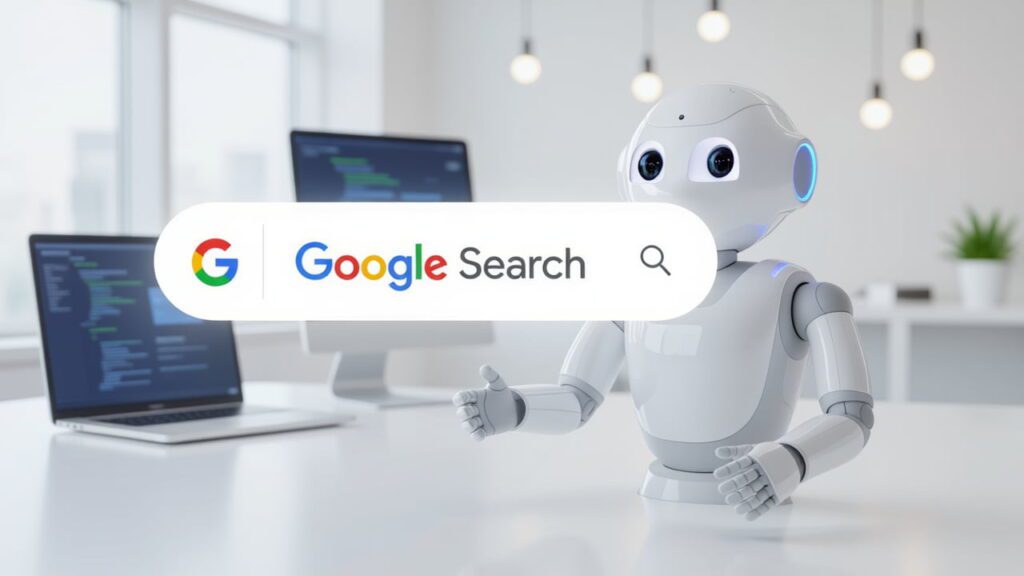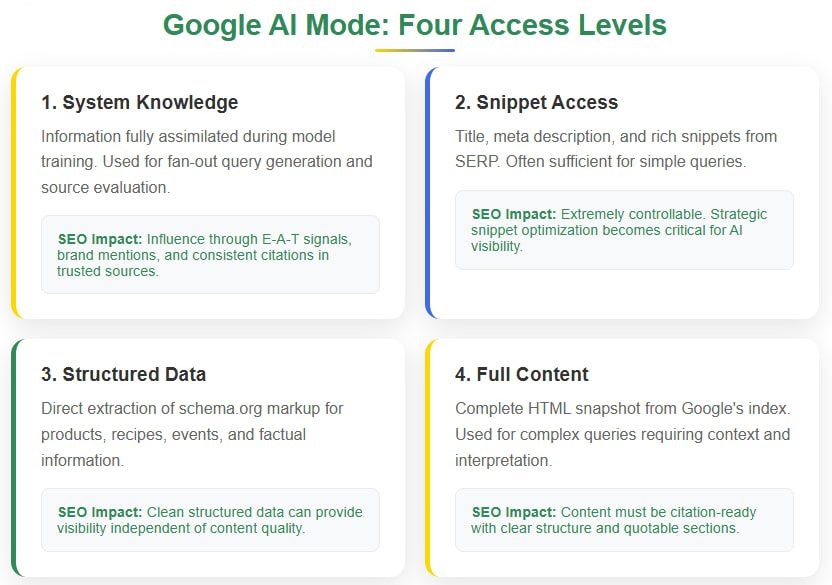
Summary
The emergence of Google’s AI Mode as a replacement to traditional search and insights from the leaked ChatGPT 4o system prompt provide insights on how LLMs handle accessing live data. While SEO is not dying (again), its mechanisms are being dramatically restructured. The traditional model of consistent rankings is giving way to dynamic, context-dependent visibility that depends on AI agents’ real-time decisions about which sources to access and how deeply to analyze them. In this article we cover how Google’s AI mode actually works, how ChatGPT differs and provide actionable fundamentals for the AI era.
What remains constant:
- Technical SEO fundamentals (indexing, snippets, structured data) remain prerequisites for visibility
- Clean semantic foundations are still essential for AI systems to process content effectively
What’s changing:
- Visibility is now determined by dynamic “fan-out” processes where AI systems generate multiple search queries and selectively analyze sources
- Four distinct access levels determine how deeply AI systems engage with content
- Success depends on understanding prompt types and their corresponding AI behaviors

How Google’s AI Mode Actually Works
Google’s AI Mode doesn’t simply generate answers from static knowledge, it operates as a sophisticated search agent that executes multiple parallel queries and makes real-time decisions about source analysis depth.
The Fan-Out Process: Multiple Queries, Selective Analysis
Even for seemingly simple questions, AI Mode automatically generates multiple synthetic search queries to approach topics from different semantic angles. This “fan-out” process allows the system to:
- Generate 5-10 related search queries from a single user question
- Analyze 50-100 potential sources simultaneously
- Make individual decisions about how deeply to process each source
Example: A user asks about “best espresso machine under $300 for beginners”
The AI Mode generates searches like:
- “espresso machine beginner guide under 300”
- “affordable espresso maker reviews 2025”
- “entry level espresso machine comparison”
- “best budget espresso machines coffee enthusiasts”
Four Access Levels: How Deep Does AI Go?

Google’s AI Mode operates with four distinct access levels, each serving different efficiency and accuracy needs:
1. System Knowledge (Model Training Data)
- Description: Information fully assimilated during model training which is usually months behind current search index.
- SEO Relevance: Indirectly controllable through E-A-T signals, structured mentions, thematic coherence, and consistent citations in trusted sources. In other words, backlinks on prominent resources and strong content clusters.
- Impact: Important for brand and topic anchoring in future model versions.
2. Snippet-Only Access (SERP Elements)
- Description: Considers the Title, meta description, and visible rich snippets. Most web search APIs will serve results in this format and for basic requests this is all the augmentation AI needs.
- SEO Relevance: Extremely controllable, often determines visibility alone and is the core concept behind AIO Meta optimization.
- Impact: Strategic snippet optimization becomes critical for AI agent appeal and planning of content coverage for suitable snippet coverage.
3. Structured Data Access
- Description: Targeted extraction of schema.org markup (Product, FAQ, Recipe, etc.)
- SEO Relevance: Highly relevant for products, events, recipes, and factual data like FAQs
- Impact: Clean structured data can override poor content quality in LLM responses, use FAQs to target fan out variants and entity rich article schema.
4. Indexed Full Text
- Description: AI Mode renders a Complete HTML snapshot from Google’s index
- SEO Relevance: Semantically controllable through clear statements, standalone sections, and logical topical structure.
- Impact: Content must be formulated for AI citation and summarization in mind, be concise, provide stats, vary html types etc etc.
No Live Access: Everything Depends on Indexing
A crucial limitation: AI Mode has no live browser access. All information comes exclusively from Google’s stored index. Content that isn’t crawled and indexed remains invisible to AI Mode, even when explicitly mentioned in prompts. So like with traditional SEO, sites need external authority and well structured content to appear highly in these indexes.
The ChatGPT Contrast: When Search Rarely Happens
The leaked ChatGPT 4o system prompt reveals a starkly different approach that highlights Google’s unique position:
ChatGPT’s Restrictive Search Policy
ChatGPT 4o only activates web search under extremely limited conditions:
- Real-time information (weather, sports scores)
- Location-specific queries
- Niche topics not in training data
- Situations where outdated information could be harmful
The key restriction: “Avoid using the web tool for information already known to be available internally unless the user explicitly indicates preference for public sources.”
The Link Scarcity Problem
This restrictive approach creates a fundamental visibility challenge:
- SISTRIX data shows ChatGPT links to external sources in only 6.3% of responses
- Gemini links in 23% of cases
- Overall average across AI chatbots: just 13.95%
Why LLMs Don’t Store URLs Reliably
Large language models fundamentally lack persistent URL indexes. When URLs appear in responses, they’re probabilistically reconstructed from training data, leading to:
- Frequent 404 errors
- Outdated page references
- Fictional URLs that never existed
This is why live search becomes crucial: Only through real-time search can AI systems retrieve actual, functional links.
Understanding Prompt Types and AI Responses
Different query types trigger different AI behaviors and access depths:
Mode A: Snippet-Only Responses
Examples:
- “What is REI’s return policy?”
- “Apple AirPods Pro price”
- “Best Buy shipping times”
AI Behavior: Relies entirely on SERP snippet information without deeper page analysis.
SEO Implication: Snippet optimization becomes the primary visibility strategy.
Mode B: Structured Data Focus
Examples:
- Product availability queries
- Recipe nutrition information
- Event date requests
AI Behavior: Targets specific schema.org markup while ignoring surrounding content.
SEO Implication: Clean structured data can provide visibility regardless of content quality.
Mode C: Full Content Analysis
Examples:
- “Compare customer reviews between retailers”
- “Summarize the key arguments from this blog post”
- “What does the return policy say about used items?”
AI Behavior: Analyzes complete indexed content for context and interpretation.
SEO Implication: Content must be semantically clear and citation-ready.
The New SEO Fundamentals for AI Mode
1. Indexing Remains Non-Negotiable
AI Mode can only access indexed content. Technical SEO basics become even more critical as the foundation for any AI visibility.
2. Snippet Optimization Gains Strategic Importance
Snippets now serve dual purposes:
- Attracting human clicks in traditional search
- Convincing AI agents that content deserves deeper analysis
3. Structured Data Becomes a Competitive Advantage
Clean schema.org markup provides:
- Efficient data extraction for AI systems
- Higher processing priority than unstructured content
- Direct answers to specific query types
4. Content Must Be Citation-Ready
AI systems need content that can be:
- Easily extracted and summarized
- Quoted without extensive context
- Understood in isolation from surrounding content
The Visibility Challenge: Context-Dependent Rankings
Unlike traditional SEO where rankings provide predictable visibility, AI Mode visibility is:
- Situational: The same content may appear for some queries but not others
- Prompt-dependent: Small changes in question phrasing can dramatically affect source selection
- Dynamically filtered: Sources are evaluated and rejected at multiple stages
The Multi-Stage Filtering Process
- Fan-out generation creates multiple search queries
- Initial snippet evaluation filters out irrelevant sources
- Depth decision determines how thoroughly to analyze remaining sources
- Final integration decides which sources to cite in the response
Measuring Success in the AI Era
Traditional SEO metrics become insufficient. New measurement approaches must consider:
Prompt Analysis
- Which questions trigger AI responses in your sector?
- What source types does AI prefer for different query categories?
- How does AI behavior vary across different user contexts?
Source Attribution Tracking
- Which domains appear most frequently in AI responses?
- What content types generate the most AI citations?
- How does AI source selection change over time?
Traffic Pattern Changes
- What percentage of traffic now comes through AI-mediated interactions?
- How do AI-driven visits behave differently from traditional search traffic?
- What conversion patterns emerge from AI referrals?
The Future of SEO: Data-Driven but Contextual
The AI Mode era demands a fundamental shift in SEO thinking:
From Static Optimization to Dynamic Relevance
- Old approach: Optimize for consistent rankings
- New approach: Optimize for contextual relevance across multiple scenarios
From Broad Keywords to Specific Prompt Patterns
- Old approach: Target keyword clusters
- New approach: Understand and optimize for specific question patterns that trigger AI responses
From Page-Level to Content-Element Optimization
- Old approach: Optimize entire pages
- New approach: Optimize specific content elements (snippets, structured data, quotable sections) for AI extraction
Conclusion: SEO Evolves, Doesn’t Disappear
The AI Mode revolution doesn’t eliminate SEO, it makes it more sophisticated and contextual. Success requires understanding:
- How AI systems make access decisions across different content types
- Which prompt patterns trigger different AI behaviors
- How to structure content for optimal AI processing and citation
- When and how AI systems choose sources for different query types
The winners in this new landscape will be those who understand that visibility is no longer about ranking, it’s about becoming the right answer at the right moment for the right AI-mediated question. In other words being the Topical Authority for your niche.
As we move forward, SEO professionals must develop new skills in prompt analysis, AI behavior understanding, and context-dependent optimization. The fundamentals remain, but the application becomes far more nuanced and data-driven.
The future belongs to those who can think like an AI agent while optimizing for human value, the human first web will quickly become a machine based web. Understanding not just what content to create, but how to structure it for maximum AI accessibility and citation potential becomes key for SEO or AIO as some like to call it. At TBS Marketing AI has been integral to our processes for years and we have a strong understanding of lexical semantics and information retrieval engines, don’t let AI leave you behind and let us guide you through this profound period of change.
